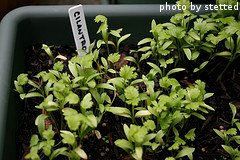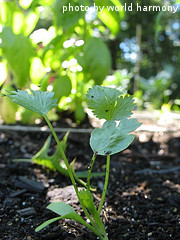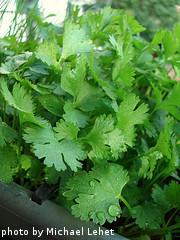Planting Cilantro - A How-To Guide
When planting cilantro, you can sow the seeds directly in the garden or full-sized container. The plants grow relatively quickly and can tolerate light frosts. If you live in an area that has a short spring, you can start the seeds in peat pots and then set the pots in the garden a couple of weeks before the last expected frost in your area.

Cilantro plants have sensitive root systems that don't like to be disturbed. If you try to start the seeds in plastic pots, expect a high failure rate after transplanting. Peat pots are a much better alternative because you don't have to remove the seedling from the pot before transplanting it. The whole pot can be planted in the ground and will break down over time. Additionally, peat pots have nutrients in them that will help the seedlings to grow. Another option is using biodegradable pots made from newspapers. These are easily made yourself using a wooden pot maker.
If you want to plant cilantro seeds in peat pots, they can be purchased at your local garden center. Fill the pots with good quality topsoil or potting mix and plant 2 seeds in each pot, about 1/4 inch deep. Cover the seeds with soil and water them in well. They take 7-10 days to germinate. Once the seedlings emerge, thin to one plant per pot. When the plants are a couple of inches tall, they can be transplanted into the garden.

Before planting the peat pots, make sure the soil is tilled well to a depth of at least 6 inches. Use a trowel and dig a hole slightly wider and deeper than the peat pot. Place the peat pot in the hole and backfill with dirt. After planting cilantro, lightly tamp down the soil around the plant and water it in well. As the plant grows and the root systems spread out, the pots will begin to break down. Occassionally you might find a pot that is still partially intact at the end of the growing season. You can just till it into the garden soil.
Planting Cilantro Seeds Directly In Your Garden
Cilantro seeds can be sowed directly in the garden beginning about 4 weeks before the last expected frost in your area. Make sure the soil is tilled to a depth of 6 inches. Use a hoe to create a shallow row, 1/4 inch deep. Scatter the seeds in the row, spacing them 6 inches apart. If planting more than one row, space the rows at least 1 foot apart. After planting the seeds, cover them with soil and tamp it down lightly before watering them in.
In our own garden, we scatter a balanced granular fertilizer at a rate of 1 pint per 100 square feet in the area we want to plant cilantro. We also add pulverized lime as our garden soil is a bit acidic and lacks calcium. We till these additives into the soil and then water them in. We then wait about a week before tilling one last time. We then use a shovel to build raised rows that are approximately 6 inches across and 6 inches tall. Then we plant our cilantro seeds in these raised rows. The raised rows help with drainage. They also make it just a little bit easier to harvest the cilantro because we don't have to bend down quite as far.
To have fresh cilantro all summer long, plant seeds in the garden every 2-3 weeks. This way, as the first plants begin to turn to seed, the younger plants will be ready to harvest.
To plant a fall cilantro crop, sow the seeds 6-8 weeks before the first expected fall frost in your area. This will give the plants enough time to develop enough leaves that can be harvested before the cold weather sets in. If planting cilantro in the fall, there usually isn't enough time for the plant to develop seed pods before a cold snap kills the plants.

If you want to grow cilantro in a container, follow the directions listed above. Choose a container that is at least 8 inches deep and 16 inches across. Make sure there are holes in the bottom of the container for adequate drainage. Evenly space 3-4 seeds in the pot, planting them 1/4 inch deep. Cover the seeds with loose soil and water them in well. When the seedlings are a couple of inches tall, thin plants so they are spaced about 6 inches apart.
Now that you know about planting cilantro, it's time to think about watering and fertilizing your cilantro plants.
Click here for information about fertilizing and watering cilantro
Click here to learn about harvesting cilantro
Click here for some of our favorite cilantro recipes
Click here to move from our Planting Cilantro page to our Growing Cilantro main page
Click here to go to our Home page